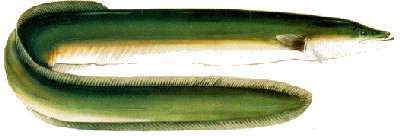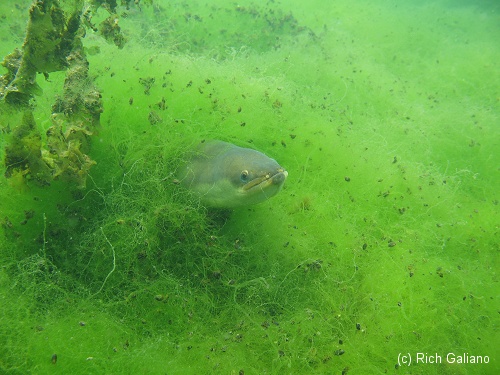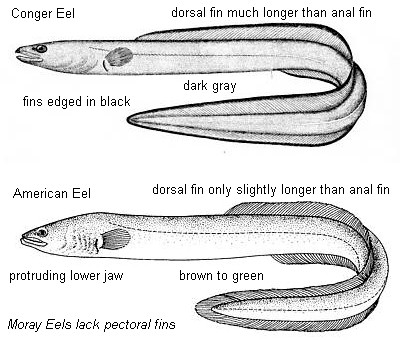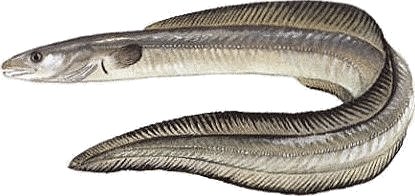American Eel

Anguilla rostrata
Size
to 60"
Species Profile
By Jeff Brust,
Research Scientist
American eels are an ecologically unique and important species that occur in fresh, brackish, and marine waters from the southern tip of Greenland to northeastern South America. This species is closely related to the European eel. Eels support a valuable commercial food fishery, are used widely as bait for sport fish such as striped bass and cobia and are an important food source for many fish and wildlife species.
Life Cycle
American eels are a catadromous species, which means they spend most of their life in freshwater or brackish water, but when they mature, they migrate to the ocean to spawn once and die. Spawning has never been directly observed, but spawning grounds have been identified based on collection of larval eels. Current scientific evidence indicates that adult eels spawn in the Sargasso Sea, an area of the Atlantic Ocean south of Bermuda and east of the Bahamas. Some eels may migrate thousands of miles to reach the spawning grounds.
Spawning is believed to occur around January or February. After hatching and a brief pre-larval phase, American eels enter a larval phase known as a leptocephalus, which resembles the leaf from a willow tree. Eels remain in the leptocephalus stage for approximately one year, during which ocean currents transport the larvae to coastal areas throughout their range.
Generally, from February to April, the larvae reach coastal areas in New Jersey and begin transforming into the more recognizable eel body form about 2 to 2.5 inches long. At this stage, they are transparent and are called glass eels. They enter estuaries (where freshwater mixes with ocean water) such as bays and river mouths and begin to migrate upstream toward freshwater. As they migrate, the glass eels begin to darken in color. By late spring, most are fully pigmented and referred to as green eels or yellow eels.
Yellow eels remain in fresh or brackish water until they reach maturity. Some will remain near the estuary, while others move several hundred miles upstream to live in streams, rivers, lakes, and ponds. Most upstream movement occurs between March and October every year, and some eels will continue to move farther and farther upstream every year until they reach sexual maturity. There is some evidence that eels remaining in brackish waters generally mature into males, while those that move farther upstream mature into females.

Eels are generally nocturnal, spending most of the day hidden among rocks and other structures or buried in mud bottoms. At night, eels will venture from their hiding places to feed on small fish, insects, snails, clams, and worms, among other prey.
Females generally live longer and grow larger than males. Males reach maturity in five years to seven years at a size of about 11 inches or greater. Females, however, may take 15 years to 20 years to reach maturity at a size of 18 inches or greater. Very few males grow larger than 15.5 inches, but females may grow more than 39 inches. Plainfield resident David Payne learned firsthand just how large eels can grow. While trout fishing in Round Valley Reservoir last June, he landed the New Jersey freshwater state record American eel, which measured 41 inches and weighed 6 pounds, 13 ounces. Almost certainly a female, the eel was sent to Dr. Ken Oliveira at the University of Massachusetts at Dartmouth who determined that the eel was 16 years old when it was captured. According to Dr. Oliveira, the eel would have continued to live, and possibly grow, for several more years had it not been caught.
Following the yellow phase, which lasts 6 years to 16 years in the Chesapeake Bay region, eels begin to mature, and their appearance and body functions change. Externally, the eel's body fattens, its eyes enlarge and its skin thickens. The coloration on its back changes to dark bronze or black, and its belly is white. These eels typically have a silvery sheen and are aptly named silver eels. Internally, the eel's digestive system shrinks; it stops feeding, and its swim bladder, gills, and other organs change to enable its survival in seawater. These changes occur during the summer when maturing eels begin migrating downstream. Silver eels leave rivers and coastal areas in late summer and early fall.
Their migration occurs mostly at night, coinciding with rising water levels and the moon's new and full phases. Little is known about the distribution and timing of the spawning migration once the eels enter the ocean, but it is believed that they make their way to the Sargasso Sea to spawn and then die.
Environmental Tolerances and Concerns
Historically, eels were abundant on the Atlantic coast. Estimates suggest that eels could comprise up to 25 percent of the total fish biomass in a stream. In addition, eels are an extremely hardy species and can adapt readily to their environment. They can withstand temperatures ranging from below freezing to nearly 100°F for short periods. During the winter or in drought conditions, eels can bury themselves in mud to escape harsh conditions. They can absorb oxygen across the skin and can survive out of the water for longer periods than most fish. Young eels have been observed climbing dam walls and other obstructions or traveling on land around obstructions.
One eel was known to have been held in captivity for 85 years. Despite their adaptability, eels are susceptible to a wide range of impacts that can affect their survival. Fisheries exist for glass, yellow, and silver eels, which are used for food and bait. Dams and other structures hamper upstream and downstream movements and have significantly decreased the amount of suitable habitat available to eels.
In addition, the high-fat content of the American eel and its bottom-dwelling lifestyle make it prone to accumulate contaminants that may increase mortality or reduce reproductive potential. Eels are susceptible to a parasite that can invade the swim bladder, affecting survival and reproduction. It is important to note that each of these mortality factors impacts eels before they can spawn which could result in decreased eel populations in the future.
Because of their unique lifestyle and ecological role, there are still large gaps in our knowledge of eel biology and how the population responds to different factors. Recent data from the Atlantic coast of the U.S. and Canada suggests that American eels are at or near historic low levels of abundance. These findings have sparked great interest and concern in eel biology and population management. The research results will guide fisheries managers to maintain healthy eel populations at levels permitting sustainable use by anglers and for the marine resources that depend on this distinctive species.
This article first appeared in New Jersey Fish & Wildlife Digest - 2006 Marine Issue
Anguilla and rostrata are both Latin, meaning "eel" and "beaked, " respectively. The latter is probably a reference to the fish's snout. The American eel has a slender snakelike body with very small scales, and the fish may appear naked. A long dorsal fin usually extends for more than half the length of the body and is continuous with a similar ventral fin. Pelvic fins are absent. The back may be olive-green to brown shading to greenish-yellow on the sides and light gray or white on the belly.



